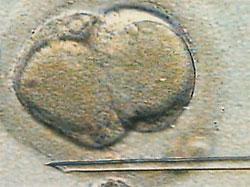
ASSISTED HATCHING
Failure of IVF is most frequently due to a failure of implantation. Even if good quality embryos are replaced, a pregnancy may still not occur. It is thought that a thickened or hardened outer covering of the embryo known as the zona pellucida may be a factor in preventing implantation and pregnancy.
In order for implantation to take place, the embryo must first “hatch” through the zona. Sometimes a thickened zona may prevent the embryo from hatching. To overcome this possible cause of failure to implant, the technique of assisted hatching has been developed. It is thought that if the zona can be breached mechanically by making a slit with an ICSI needle, a laser or a portion dissolved chemically, this will improve subsequent hatching and implantation when the embryo develops on to become a blastocyst.
Assisted hatching is performed just before embryo transfer and takes only a few minutes. Some centres will offer assisted hatching to selected groups of patients:
- over the age of 38 years, as it is thought that the zona hardens with age;
- three previous unsuccessful IVF cycles where embryos have been of good quality;
- where eggs appear to have a thickened zona at the time of egg collection;
- frozen embryo transfers of patients who have had three unsuccessful IVF attempts or whose embryos appear to have a thickened zona.
It must be stressed that there is no guarantee that assisted hatching will result in a pregnancy. Indeed the jury is still out over whether or not there are any benefits to be achieved from assisted hatching. It is even possible that the procedure could lead to the damage of some embryos so that they will not be suitable for transfer.
The embryologist at your centre will be happy to discuss assisted hatching with you.
March 2009
